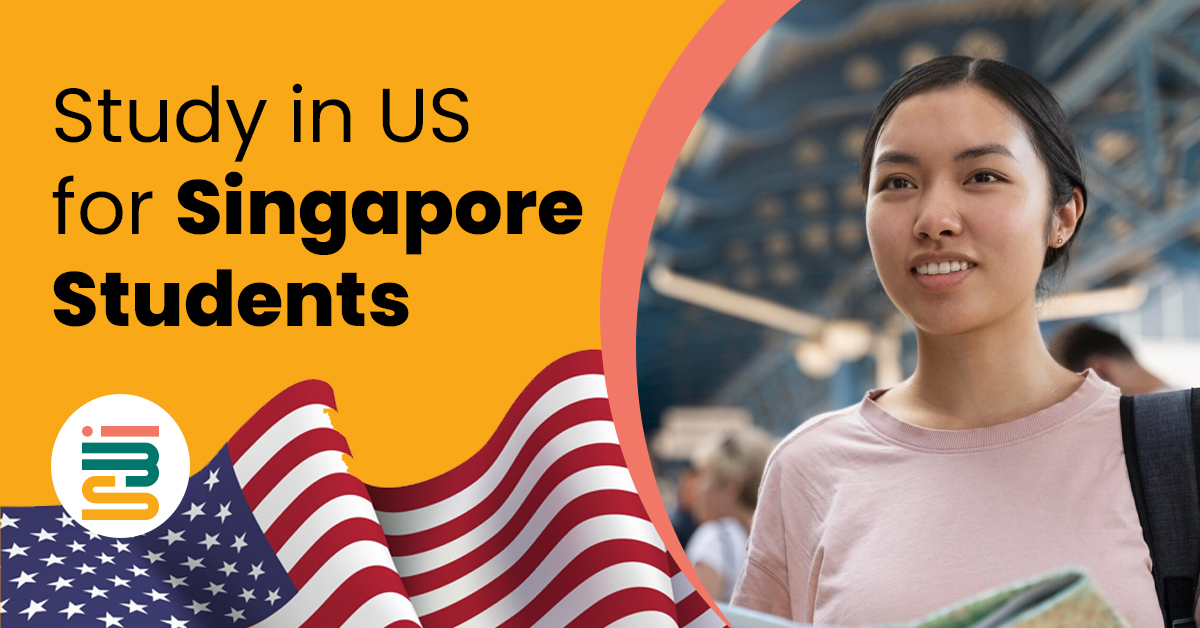I know it sounds simple on paper.
Apply. Get your visa. Go.
But every year, thousands of Singapore students run into unexpected problems while trying to study in the USA. Not because they didn’t try hard enough. But because they missed a few small steps that made a big difference.
Did you know that in 2023, over 3,000 students from Singapore were enrolled in US universities? (Source: IIE Open Doors) Many started out unsure, lost in paperwork, confused about school choices, or stuck waiting on visa approvals. Some didn’t know where to look for scholarships. Others chose schools without comparing tuition or living costs.
That’s why help matters.
At IBS Consulting, we don’t just point the way.
We walk with you; one form, one school, one answer at a time.
Whether you need help finding affordable schools, applying for scholarships, getting a visa, writing your personal statement, or picking a course that fits your future, we’ve got you.
This guide walks you through everything you need to know about the study in the US for Singapore students.
Step by step.
Clear. Simple. No stress.
Why Study in the US as a Singapore Student
Choosing to study in the US for Singapore students is a decision that opens up many exciting opportunities. Here are a few reasons why it makes sense:
Top-tier Education
The US is home to some of the best universities worldwide, offering world-class programs in nearly every field imaginable. Whether you’re interested in business, technology, or the arts, there’s something for everyone.
Curious about the advantages of pursuing your studies overseas? Reach out to IBS Consulting and book your FREE consultation to learn more!
Book Your Free Consultation
Cultural Exposure
By studying in the US, you will meet people from all over the world. This will help you build a global network, making connections that could benefit your future career. The US is incredibly diverse, with students from many different countries and backgrounds.
Personal Growth: Living and studying in a new country will challenge you to become more independent and confident. You will learn how to manage your time, make decisions on your own, and adapt to new situations, all of which will shape you into a more resourceful person.
Career Opportunities
Many Singaporean students find that studying in the US opens doors to a wide range of career opportunities. The experience of studying abroad, particularly in a country like the US, is often seen as a huge advantage when looking for jobs later on.
Different Learning Style
In the US, education is interactive. Unlike Singapore, where students are often expected to listen and learn, in the US, the emphasis is on participation. Students are encouraged to ask questions and take part in class discussions. You will also have the freedom to choose your courses, allowing you to shape your own learning journey.
More and more Singaporeans are choosing to study in the US. Many find that it helps them become more open-minded, confident, and ready for the challenges of a globalized world.
Who Can Apply to US Universities from Singapore?
If you’re wondering, “Who can apply to US universities from Singapore?” the good news is that nearly every student who has completed high school or an equivalent program can apply. These are the main groups that usually apply:
- O-Level or N-Level students: If you’ve completed O-Levels or N-Levels, you’re eligible to apply to US universities. You’ll need to demonstrate your academic performance and English proficiency.
- A-Level Graduates: After completing A-Levels, many students opt for further studies in the US. Your A-Level results will be key to the application process.
- IB (International Baccalaureate) Students: If you’re an IB student, you’re already familiar with a rigorous academic structure. US universities value the IB diploma highly, and it can make your application stand out.
- Polytechnic Diploma Holders: Polytechnic students can also apply, though you may need to apply as a transfer student to some universities. This is a good option if you have completed a specialized program.
- Students with Other International Diplomas: If you’ve earned a diploma from another country, you’re also eligible to apply. Make sure your academic qualifications match the entry requirements of your chosen university.
What Do US Universities Want from Students?
When you’re applying to study in the US for Singapore students, it’s important to know what universities are looking for in an applicant. Here’s what they typically want:
- Good GPA or School Grades: Your academic performance plays a crucial role in the application process. The higher your grades, the better your chances of being accepted.
- English Test Scores (TOEFL or IELTS): US universities want to make sure that you can understand and communicate in English. A strong TOEFL or IELTS score is a must for most universities.
- SAT or ACT Scores: Some schools will ask for SAT or ACT scores, though not all universities require them anymore. It’s important to check with each university to know their specific requirements.
- A Personal Essay: A personal essay is your chance to show who you are beyond your grades. Universities want to understand your motivations, goals, and why you want to study in the US.
- Letters from Teachers: Letters of recommendation can strengthen your application, especially if your teachers can speak to your academic abilities and character.
Most Singaporean students apply after junior college (JC) or polytechnic, and both paths are accepted by US universities. However, if you’re a polytechnic graduate, you may need to apply as a transfer student.
How to Apply for US University from Singapore Step-by-Step
Here is How to apply for US university from Singapore step-by-step, follow these simple steps:
Step 1: Research and Choose Schools
Start by researching universities that offer the programs you’re interested in. Look at factors like location, course offerings, tuition costs, and university ranking to make an informed decision.
Step 2: Check Deadlines and Requirements
Each university has its own deadlines and entry requirements. Be sure to check the university websites to make sure you’re on track.
Step 3: Apply through the Common App or Directly
Many US universities use the Common App (commonapp.org), which allows you to apply to multiple universities with one application. However, some universities have their own application process, so make sure to check their specific requirements.
Step 4: Submit School Results and Essay
After filling out the application, submit your academic records and personal essay. Your essay is a chance to show your personality and why you’re a good fit for the university.
Interested in learning more about the benefits of studying abroad? Call IBS Consulting to schedule a FREE consultation right away!
Book Your Free Consultation
Step 5: Pay Application Fees
Most US universities charge an application fee. This typically ranges from $50 to $100 USD per school. Be sure to have the funds available to pay this fee when submitting your applications.
By following these steps, you can easily navigate the process of applying to a US university. The key is to stay organized and make sure you meet all deadlines.
What Tests Do You Need? (SAT, TOEFL, IELTS)
As a Singapore student, you’ll most likely need to take at least one English language test to be admitted to a US university. The two main tests are:
TOEFL (Test of English as a Foreign Language)
This is required by most universities to assess your English proficiency.
IELTS (International English Language Testing System)
Some universities accept IELTS as an alternative to TOEFL. Be sure to check which test your university prefers.
In addition to English tests, some universities require you to take the SAT or ACT. These standardized tests measure your readiness for university-level education and are required by some schools, though many universities have become test-optional. Always check with the specific university to know what is required.
You can take these tests at locations in Singapore. Register early to get the test date and time that works best for you, and use free online resources to help you prepare.
Getting a US Student Visa (F-1 Visa Guide)
Once you’re accepted into a US university, you’ll need to apply for an F-1 student visa. Here’s how to get your US student visa:
Step 1:
Get Accepted by a US School: Your chosen university will send you an I-20 form, which you’ll need to apply for the visa.
Step 2:
Pay the SEVIS Fee: The SEVIS fee is a one-time fee of $350 USD that must be paid before applying for your visa.
Step 3:
Fill out the DS-160 Form: This is your visa application form. Complete it online and print out the confirmation.
Step 4:
Book Your Visa Interview: You’ll need to schedule an appointment at the US Embassy in Singapore for your visa interview.
Step 5:
Attend Your Visa Interview: Bring all necessary documents, including your I-20, passport, DS-160 confirmation, SEVIS receipt, and any school documents. During the interview, you’ll be asked about your course, your plans, and your finances.
How Much Does It Cost to Study in the US?
Many parents and students from Singapore often ask how much does it cost to study in the US for Singapore students?
The answer?
It depends.
It depends on your university, your city, and your lifestyle.
Let’s break it down.
| Expense | Estimated Cost |
| Public University Tuition | $10,000 – $30,000 per year |
| Private University Tuition | $30,000 – $60,000 per year |
| Living (Big Cities) | $1,500 – $2,500 per month (e.g. New York, LA) |
| Living (Smaller Towns) | $800 – $1,200 per month |
| Books & Supplies | $500 – $1,000 per year |
| Health Insurance | $1,000 – $2,000 per year |
| Transport | $50 – $150 per month |
| Clothes, Personal Needs | $500 – $1,000 per year |
Yes, it adds up. But don’t worry, many students manage costs well.
How?
Money-saving tips:
- Share a room or rent with friends
- Cook instead of eating out
- Use student discounts for transport, food, and movies
- Buy used books or borrow from the library
If you’re wondering how to study in USA from Singapore without breaking the bank these tips really help.
Scholarships and Financial Aid for Singaporean Students
Here’s the good news: you don’t have to pay everything yourself.
>Contact us
Many universities offer help to study in the US for Singapore students.
Types of financial help:
- Merit scholarships: for good academic results
- Need-based aid: for students from families with less income
- Singapore-based scholarships: from organizations in Singapore
Look out for:
- Public Service Commission (PSC) Scholarships
- Singapore American School scholarships
- Local banks or private sponsors
Tips for getting aid:
- Apply early
- Write a strong essay
- Share your story, include leadership or volunteer work
- Show your goals and why you want to study in the US
This step is key in your journey if you’re asking: How to apply for US university from Singapore step-by-step. Scholarships can help you go far.
Before You Travel. What You Must Do
Before you pack your bags to study in the US for Singapore students, there are important things to do:
Travel checklist
- Apply and get your Singapore student visa for USA.
- Book your plane ticket early.
- Get travel insurance.
- Finish all required vaccinations.
- Keep printed and digital copies of your passport, visa, and school documents.
What to pack
- Passport + Visa
- School I-20 form
- Weather-appropriate clothes
- Laptop, charger
- Medication with doctor’s letter
- Some local snacks (you’ll miss them)
What Life Feels Like in the US as a Singaporean Student
It’s exciting to move. But it’s also a big change.
Here’s what many students from Singapore notice after arriving:
- Food: Meals are big. You might miss chicken rice or laksa, but many cities have Asian grocery stores.
- Weather: Some places snow. Buy thick jackets, boots, gloves, especially if your school is in a cold state.
- Talking to people: People talk to strangers. That’s normal in the US. Just smile and reply politely.
- In class: You’ll be asked to talk more. Don’t be shy, your ideas matter.
- Safety: Lock your room. Carry your ID. Follow school safety tips.
Stay connected
- Use apps like WhatsApp or FaceTime to call home.
- Join clubs with other Singaporeans.
- Make friends from all over the world.
These tips help if you’re planning how to study in USA from Singapore and want to feel at home.
Can You Work or Stay in the US After School
Many students ask “Can I stay in the US after I finish studying?”
Yes, you can.
If you are on an F-1 visa, you can apply for OPT (Optional Practical Training). That lets you work for 12 months after graduation.
If your course is in science, technology, engineering, or math (STEM) , you may be allowed to work for up to 3 years.
Some lucky students even get full-time jobs and switch to a work visa (H-1B).
So, your study journey can lead to job opportunities too.
This is a common step in the how to apply for US university from Singapore step-by-step process, especially if you’re planning long-term.
Why IBS Consulting?
You’re excited. But also scared. That’s normal.
Here’s what many Singapore students worry about:
- How do I choose the right school?
- What if I can’t afford the fees?
- What if my visa gets rejected?
- What if I get lonely or lost in the US?
At IBS Consulting, we listen to all these worries.
We help you step by step from choosing the best US universities for Singaporeans, applying for your Singapore student visa for USA, finding scholarships, to settling in.
You’re not just another number. You’re a student with dreams. And we’re here to help you turn them into real results.
Many Singaporean students who study in the US today started their journey with IBS. We care. We guide. We make it happen.
Your Next Step
Don’t rush.
Take a step at a time.
And plan.
Whether you’re in JC, poly, secondary school or already graduated you can study in the US for Singapore students.
This guide shared the basics, tuition, life, scholarships, and jobs.
But your journey is personal. And you don’t have to do it alone.
Talk to IBS Consulting today.
We’ll help you every step of the way.
Visit IBS Consulting. Your dream is closer than you think.





